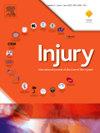Long bone fractures with associated vascular injury: Who should go first?
IF 2.2
3区 医学
Q3 CRITICAL CARE MEDICINE
Injury-International Journal of the Care of the Injured
Pub Date : 2025-01-20
DOI:10.1016/j.injury.2025.112174
引用次数: 0
Abstract
Objectives
Long bone fractures with concomitant vascular injury have the potential to be life and limb threatening injuries, with increased risk for limb loss. There is currently no established surgical order of operations for orthopaedic and vascular intervention. This study compares injury classification, warm ischemia time and patient outcomes in patients with long bone fractures and associated vascular injury after orthopaedic versus vascular primary intervention.
Methods
Design: Retrospective review
Setting: Level 1 Trauma Center
Patient Selection Criteria: Included were patients treated between 2016 and 2021 with fractures of the femur, tibia, fibula, or knee dislocation (OTA/AO 32, 33, 41, 42 and 43) with associated vascular injury necessitating vascular repair.
Outcome Measures and Comparisons: Warm ischemia time, intraoperative transfusion requirements, readmission, definitive amputation, fasciotomy, infection, need for vascular revision, and return to weight bearing were compared between the two groups (primary vascular intervention (VP) and primary orthopaedic intervention (OP)).
Results
35 patients were included with 29 patients in the VP group and 6 patients in the OP group. There was no significant difference in the warm ischemia time between groups (p = 0.52) or total operative time (p = 0.13). 3/29 patients in the VP group required definitive amputation and 0/6 patients in the OP group required amputation (p = 1.00). There were no statistically significant differences in rates of infection, fasciotomy, readmission, length of stay, vascular revision, or time to weight bearing between groups.
Conclusions
This study demonstrates collaborative care between surgical teams to minimize warm ischemia time is crucial in patients with lower extremity fractures associated with vascular injury. There is no significant difference in patient outcomes including definitive intraoperative transfusion requirements, amputation, time to weight bearing or infection when comparing primary orthopaedic versus vascular intervention.
求助全文
约1分钟内获得全文
求助全文
来源期刊
CiteScore
4.00
自引率
8.00%
发文量
699
审稿时长
96 days
期刊介绍:
Injury was founded in 1969 and is an international journal dealing with all aspects of trauma care and accident surgery. Our primary aim is to facilitate the exchange of ideas, techniques and information among all members of the trauma team.

 求助内容:
求助内容: 应助结果提醒方式:
应助结果提醒方式:


